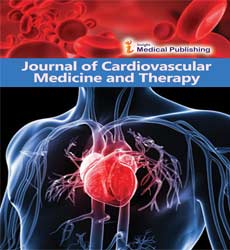The Rise of Cardiovascular Medicine
Lisa Johnny*
Department of Medical Science, American University of Afghanistan, Kabul, Afghanistan
- *Corresponding Author:
- Lisa Johnny
Department of Medical Science,
American University of Afghanistan, Kabul,
Afghanistan,
Tel: 7208548210;
E-mail: lisajhonny218@gmail.com
Received: February 18, 2022, Manuscript No. IPJN-22-11504; Editor assigned: February 21, 2022, PreQC No. IPJN-22-11504 (PQ); Reviewed: March 07, 2022, QC No. IPJN-22-11504; Revised: March 11, 2022, Manuscript No. IPJN-22-11504 (R); Published: March 18, 2022, Invoice No. IPJN-22-11504
Citation: Johnny L (2022) The Rise of Cardiovascular Medicine. J Cardiovasc Med Ther Vol:5 No:1
Introduction
Three major discoveries ushered in modern cardiology at the turn of the nineteenth and twentieth centuries: the X-ray, the sphygmomanometer, and the electrocardiograph [1]. Cardiac catheterization was then performed, which led to coronary angiography and percutaneous coronary intervention [2]. Early reperfusion and coronary care units lowered early mortality from acute myocardial infarction and the discovery of coronary risk factors paved the way for the establishment of preventive cardiology. Several cardiac imaging techniques, the origin and evolution ocf ardiac surgery and the control of cardiac arrhythmias are all examples of notable advancements. Heart failure treatment has come a long way, [3] but it's still a difficult task. The current practice of cardiology is evidence-based and global. In cardiovascular centers and institutes, research and practice are becoming more common. In the future, there will most certainly be a larger emphasis on prevention, which will be aided by genetic data.
Rho-kinase has been identified as one of the tiny GTP-binding protein Rho's effectors. The Rho/Rho-kinase pathway has been shown to have a role in a variety of cellular processes, including actin cytoskeleton organization, cell adhesion and motility, cytokinesis and gene expressions, all of which may be involved in the pathophysiology of cardiovascular disease [4]. Rho-kinase up regulates several molecules that speed up inflammation/ oxidative tsress, thrombus formation and fibrosis at the molecular level, while down regulating endothelial nitric oxide synthase. The protein kinase C/NF-B pathway regulates Rhokinase expression, with oestrogen and nicotine acting as inhibitors and stimulators, respectively. Rho-kinase mediates VSMC hyper contraction, stimulates VSMC proliferation and migration, andi mproves inflammatory cell motility at the cellular level. Rho-kinase has been found to play a role in the pathophysiology of vasospasm, arteriosclerosis, ischemia/ reperfusion injury, hypertension, pulmonary hypertension, stroke and heart failure, as well as enhancing central sympathetic nerve activity in animal investigations.
Conclusion
Over the last 30 years, vigorous medical innovation has transformed cardiovascular medicine from a mostly non-invasive diagnostic specialty to one that employs a huge arsenal of treatments and technologies, many of which are invasive and costly.The NNT (number needed to treat) and NNH (number needed to harm) are effective in communicating clinical trial results because they stress the amount of effort required to achieve a single, measurable consequence. NNT on the other hand, represents the amount of effort required ot get a favourable result without differentiating between the presence and absence of treatment-related side effects. Similarly, NNH transmits harm without accounting for whether or not the benefit of therapy is realized [5].
References
- Braunwald E (2012) The rise of cardiovascular medicine. Eur heart j 33(7):838-846
[Crossref] [Google Scholar] [Indexed]
- Shimokawa H, (2005) Rho-kinase is an important therapeutic target in cardiovascular medicine. Arteriosclerosis, thrombosis vasc biol 25(9):1767-75
[Crossref] [Google Scholar] [Indexed]
- Mark DB (2002) Hlatky MA. Medical economics and the assessment of value in cardiovascular medicine: part II, Circulation106(5):626-30
[Crossref] [Google Scholar] [Indexed]
- Mancini GJ (1999) Reporting risks and benefits of therapy by use of the concepts of unqualified success and unmitigated failure, applications to highly cited trials in cardiovascular medicine. Circulation 99(3):377-83
[Crossref] [Google Scholar] [Indexed]
- Nicholls SJ (2006) intravascular ultrasound in cardiovascular medicine, Circulation 114(4):55-59
[Crossref] [Google Scholar] [Indexed]
Open Access Journals
- Aquaculture & Veterinary Science
- Chemistry & Chemical Sciences
- Clinical Sciences
- Engineering
- General Science
- Genetics & Molecular Biology
- Health Care & Nursing
- Immunology & Microbiology
- Materials Science
- Mathematics & Physics
- Medical Sciences
- Neurology & Psychiatry
- Oncology & Cancer Science
- Pharmaceutical Sciences
